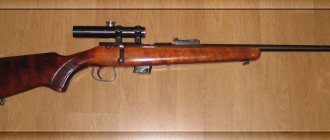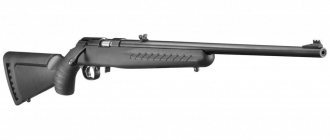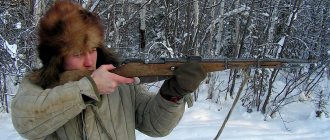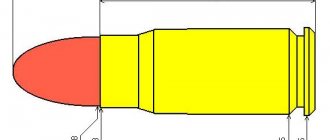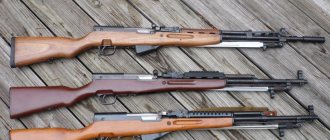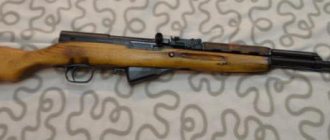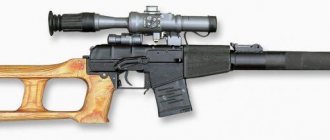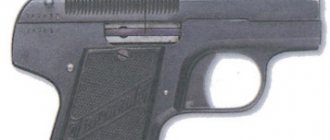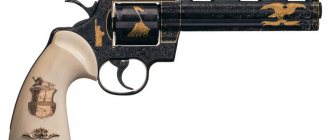Small-sized cartridges, which professionals call “small bore,” have been used by hunters for several decades. This type of ammunition is especially popular among commercial hunting shooters. Small-caliber cartridges are successfully used by both novice hunters and experienced professionals, and even by intelligence services in many countries around the world.
Why do you need a small caliber?
Small arms are a good example of how the type of ammunition is the primary factor in shooting accuracy, not the weapon. The development of the .22 LR cartridge led to a significant reduction in the cost of the shot, and the design feature of the side-firing cartridge case allowed engineers to create more than 10 types of cartridges, for which special pistols were subsequently created.
Types of 5.6 mm cartridges
The most popular small-caliber sidefire cartridges, with all their diversity, are .22 LR and .22 WMR. The first type was invented and first released over a century ago. During this time, he gained worldwide popularity, becoming the record holder for the number of shots fired. Its full name can be represented as follows: a 22 caliber cartridge, with a bullet diameter of 5.6 mm, L - long, R - rifle, as it has a rim at the bottom of the cartridge case.
Since the energy generated after a shot is quite small for "small-budget" cartridges, and the trajectory of the projectile changes greatly, they are used for shooting at a short distance from the target. They are mainly used by professional hunters for shooting small animals (rodents and birds).
In Russia, sables and squirrels are hunted using “small” cartridges, in the USA - rodents.
Many different types of weapons are produced for the .22 LR caliber: carbines, pistols and even machine guns.
The second most popular "small" cartridge - .22 LR (full name .22 Winchester Magnum Rimfire) - is available for civilian use. This caliber was especially popular in the USA. This cartridge was invented in 1959 for hunting larger animals such as coyotes or jackals. The use of such a cartridge for smaller animals does not make sense, since the ammunition seriously damages the victim’s body.
In addition, both types of “bugs” are actively used when teaching beginners how to shoot, since ammunition of this type is cheap.
We distinguish not only the caliber, but also the length of the sleeve
However, having dealt with the caliber, or, more precisely, the diameter of the sleeve, you should not forget about other parameters. Even with smooth-bore weapons, not everything is so simple. For example, knowing how many mm are in 12 gauge, it will not always be possible to buy the required ammunition. In the store, an experienced salesperson will definitely ask what kind of cartridges the buyer is interested in - 12 × 70, 12 × 76 or maybe 12 × 89! That is, its length also has a significant influence on the cartridge.
It's about the same with rifled weapons. For example, take a 9mm cartridge. This caliber was and is used in pistols such as: Makarova, Parabellum, IZH-17, Mauser. But the cartridges are completely different. The Makarov pistol requires a 9 × 18 mm cartridge. The old, proven Parabellum used 9 × 19 mm cartridges. To shoot the IZH-17 pistol, you will have to find 9 × 17 mm cartridges. Well, the famous Mauser will require 9 × 25 mm cartridges. Of course, in most cases such cartridges are not interchangeable. Most often, they simply will not fit either in the magazine or in the barrel of the gun. Sometimes there are exceptions. But even in such cases, the use of unsuitable cartridges is undesirable - most often this leads to the destruction of the pistol after several shots.
Another striking example is the already mentioned 7.62 mm caliber. For example, the SVD rifle uses 7.62×54 millimeter cartridges. And the good old AK (like the Degtyarev machine gun and the Simonov self-loading carbine) was designed for the 7.62 × 39 cartridge, innovative for its time. Of course, the characteristics of these two ammunition are very different.
Such examples quite clearly show that with the same diameter, cartridges can have different sleeve lengths. This has a serious impact not only on the combat characteristics of the ammunition, but also on the weapon for which it is designed.
Permission to fire the .22 LR cartridge
Obtaining a permit to fire small arms is no different from obtaining a permit to use a rifled barrel. The hunter must collect and submit the following documents to the MRO:
- Hunting ticket.
- Certificate of medical examination.
- A report from the district police, which contains information about the conditions of storage of firearms.
Also remember that only people who have five years of experience with a shotgun can get a rifle permit.
What comes first - the weapon or the cartridge?
As a rule, when assessing the effectiveness of a particular type of small arms, we talk about weapons. The cartridges are perceived as something like “batteries” - the weapon does not fire without them, but, by and large, they do not affect anything (well, unless they differ in type: explosive, armor-piercing, etc.). However, this is completely the wrong approach!
Ammo feed, rate of fire, stability - all this really concerns the weapon itself. But the initial speed of the bullet, its mass, armor penetration, stopping effect - this already depends on the cartridge.
The cartridge is the base! Tell me what cartridge and I will tell you most of the other characteristics of the weapon. There is nothing mystical here - the weapon is made for a cartridge, not cartridges for a weapon . If the designer provides for the acceleration of a bullet over a barrel length of approximately 70 calibers, then this is a rifle cartridge. 40-50 - transitional cartridge for carbines, etc. In other words, it is the cartridge that determines what the weapon will be: a pistol, rifle or carbine. Accordingly, the adoption of a new cartridge by a state shapes the military-production policy of this state for many years to come.
For example, the 7.62x39-mm cartridge of the 1943 model was put into service back in 1949, and is still used not only in such well-deserved models as the SKS or AK, but also in the relatively recent AK-103 and AK-104, or Saiga and Vepr carbines. In fact, the characteristics of all these small arms (and all others designed for this cartridge, even those that may yet appear in the future!) were predetermined back in 1949.
Advantages and disadvantages of “small things”
Among the main advantages of using small cartridges are the following factors:
- low noise level when shooting;
- low recoil;
- low price and availability of ammunition, which allows you to hone the shooting skills of hunters.
- a small hole in the victim’s body, allowing the integrity of the skin to be preserved;
- possibility of using a muffler;
Disadvantages of the “small” 5.6 mm cartridge:
- the ability to hit only close targets.
- low destructive force;
Feature of the 5.6 mm cartridge
The "small" 5.6 mm (.22 LR) cartridge gets its name because its bullet diameter is 0.22 inches (5.6 mm). This type of ammunition does not have a primer. In order for the shot to fire, the firing pin hits the bottom of the cartridge case from the side, which is why it is called a side-fire cartridge.
In the "small" 5.6mm cartridge, the buffer compound (also called the primer) is pressed into the edge of the case. When the shooter presses the jumper, the pistol's firing mechanism compresses the rim, igniting the primer composition. As a result of detonation, the main powder charge ignites.
Thanks to the special design, the rim of the “small” 5.6 mm cartridge is easily broken by the impact of the firing pin. The walls of the case must have a thin layer of metal that limits the maximum pressure created by the ignition of the gunpowder. If the charge in the cartridge is too strong, the cartridge may explode when fired.
First secret
1943 US President Franklin Delano Roosevelt sits in the Oval Office and deals with important government affairs. The doors fly open, “Wild Bill” Hickok Donovan bursts in, throws a sandbag into the corner and starts firing at him with a pistol.
Anyone else would not have gotten away with such an ugly trick, but, firstly, William Joseph Donovan was on good terms with the first person of the country, and secondly, he occupied the chair of the director of a very serious office - the Office of Strategic Services, OSS (OSS - Office of Strategic Services), and thirdly, the shots sounded somehow suspiciously quiet...
The “Hi-Standard HDM” was a completely conventional design: a sports pistol with a blowback bolt, a magazine capacity of ten rounds and a single-action trigger mechanism. It became silent (more precisely, relatively silent) only after installing an integrated silencer: the barrel was lightened, holes were made in it to remove powder gases, it was wrapped in several layers of metal mesh and a light casing was put on top.
Roosevelt became interested in the design and shot at the bag himself a little, causing quiet hysteria among the guards. After such baptism, a new product called “Hi-Standard HDM”, of course, went into production. The weapon was classified as “top secret” and was used only by the OSS. After the end of World War II, some of the products were taken over by business guys from the CIA, and some went to the Marines.
5.6 mm Hi-Standard HDM pistol with integrated silencer cut for clarity
Despite the fact that the pistol was considered secret the entire time it was in service, it was not possible to keep it completely secret: back in 1944, a photo of the famous Admiral Chester W. Nimitz, a man and an aircraft carrier, appeared in one of the American newspapers. The fact is that, taking advantage of his official position, the admiral grabbed one of the pistols from the USS bins and fired it for his own pleasure - it was at that moment that the camera caught him. A small scandal broke out, but it was quickly hushed up: no one dared to punish the admiral.
The ill-fated photo with Admiral Chester W. Nimitz - and the admiral’s very personal pistol, kept in the memorial museum
But the military censorship was given a serious blow to prevent them from flapping their ears and letting photographs of secret weapons leak into the open press. At first it helped, but...
Characteristics of the .22 LongRifle ammunition
- The speed at the muzzle of the bullet is from 325 to 345 m/s.
- Caliber - 5.66 mm
- The energy of the bullet after 50 meters of flight is 110 J.
- Bullet weight - 2.72 g.
- Bullet weight varies from 1.9 to 2.6 g.
- Initial bullet energy - 135 J
- Maximum powder weight 0.34 g.
- The bullet speed is about 50 meters from the muzzle of the barrel - 295 m/s.
The dimensions of the “small” cartridge are as follows:
- sleeve diameter at the top - 5.75 mm;
- cartridge length - 25 mm;
- bottom bushing diameter 7.1 mm.
- sleeve length - 15.1 mm;
History of the .22 LR
The 0.22 inch small diameter chuck was invented in the late 19th century by Stevens Arm & Tool Comp. It was equipped with a 40 grain (2.6 gram) bullet. The total weight of the black powder was 0.324 grams. At that time it was impossible to measure the speed of a bullet.
The modern Stevens Arm & Tool Comp ammunition remains virtually unchanged. The sleeve is metal, the total length of the cartridge is 25.5 mm. The main difference between the modern cartridge and the 1887 model is only that the lead bullet is now wrapped in a special casing to improve the ballistic characteristics of the ammunition.
Unlike earlier designs, the modern bullet used by hunters weighs 2.6 grams. When firing from a weapon with a barrel length of 152 mm, the maximum bullet speed after a shot reaches 345 m/s, and the muzzle energy is 140 J. When firing from a rifle with a longer barrel, the bullet speed increases by an average of 60 m/s.
In the modern world, 4 rimfire cartridges are produced:
- The most powerful of them is called hyperspeed. When fired, the bullet reaches an ultra-high speed of 425 m/s.
- The second most powerful cartridge is high-speed. Maximum speed 400 m/s.
- Side-firing ammunition with a standard bullet velocity (about 343 m/s) is called standard velocity.
- A small-caliber cartridge with a subsonic bullet speed (335 m/s) is called subsonic.
Many factors affect bullet exit velocity, such as ammo manufacturer and barrel length.
32-caliber cartridges for domestic and foreign shotguns
Photo by the author.
Smooth-bore hunting weapons of 32 caliber, as interesting and valuable as they were, remain so; they are included in the production program of our factories.
However, recently it has not been in the foreground, as modern hunting conditions have led to hunters preferring guns of larger calibers.
There are relatively few such weapons, and cartridges for them are not and have not been produced in our country.
Nevertheless, domestic 32-caliber brass cartridges were and are still being supplied for sale, initially for the “centrifuge” capsule, and later for the “jevelo” capsule.
They make it possible to supply domestic 32-caliber smooth-bore guns with cartridges of various types.
On our market, 32-caliber weapons are represented mainly by single-shot ones, including those with a folding barrel produced by the Zlatoust and Izhevsk factories.
There are also so-called conversion copies, that is, made from army carbines with a drilled barrel. Production is small, and hunters who are keen on small calibers are forced to be content with only these samples.
However, the most attractive are the 32-caliber models with a double-barrel block, valued both as a full-fledged weapon, albeit of a small caliber, and as a weapon that allows a second shot without reloading, and as an elegant product of weapons technology.
They are very rare; among the domestic ones we can only name the over-and-under “Deer” with a block of two smooth, extremely rare barrels or the even rarer Tula hammer. There is a special conversation about foreign 32-caliber smooth-bore guns.
Self-loading shotguns of 32 caliber are not produced for many reasons, including a small caliber with a small shot shell, and the insignificant power of the powder charge, insufficient for reloading by inertial or gas venting methods.
In our country, the lack of sleeves with paper or plastic shells also affects them.
Like our other hunters, I at one time hunted with a single-shot 32-caliber single-barreled shotgun with a S.A. system bolt. Mosin, commonly called “Frolovka”. The cartridges were loaded into domestic brass sleeves 70 mm long under a “centrifuge” primer with smokeless powder “Falcon”.
Later I purchased Geco 32-caliber cartridges with a paper shell and a brass cap for a “gevelo” capsule, very convenient, but they remained unclaimed because they did not fit into the chamber.
In fact, domestic and foreign 32 calibers are the same only in designation, but in fact they are different calibers, although the diameters of the barrel bores are close, since the diameters of the chambers differ significantly.
As a result, cartridges and cartridges of domestic 32-caliber smooth-bore weapons turned out to be the only ones from the entire extensive generally accepted range of smooth-bore calibers that were not interchangeable with cartridges and cartridges of foreign 32-caliber.
We had to somehow abandon the elegant, graceful hammer of the 32-caliber Belgian production only because our cartridges dangled in the chambers with a gap of 0.5 mm, and the mentioned German 32-caliber cartridges would only be enough for a few series of shots.
Photo 1 shows how much larger foreign cartridges are than domestic ones.
The history of the divergence between domestic and foreign 32 caliber is long-standing, ending at the beginning of the 20th century, during the formation of the permanent international commission CIP (PMC), which our country joined later.
To distinguish these calibers, in the middle of the 20th century we designated them as follows: 32c - Soviet, 32m - international. This need was caused by the fact that a lot of foreign-made guns entered the secondary market of that time, along with the natural supply of domestic guns from Tula, Izhevsk and Zlatoust.
The nominal diameter of the 32-caliber bore, determined by the classical method by the number of round bullets from one English pound of lead, is 13.36 mm.
But in order to clearly separate close calibers of smooth-bore weapons from unused close ones, the CIP commission back in the second quarter of the 20th century proposed a bore diameter of 12.75 mm for the 32 caliber as a nominal bore diameter with certain limits.
To be precise, this is actually a 37 caliber in terms of the number of round bullets. Domestic 32-caliber weapons have barrels with a channel of a slightly smaller diameter of 12.5 mm, which exactly corresponds to the 38-caliber in terms of the number of round bullets. But, as is customary, it is so.
Let's turn to the dimensions of the barrels, the diameters of the 32-caliber channels are equal: domestic shotguns are actually 12.5 mm, foreign ones 12.7–13.2 mm. The diameters of the 32-caliber chambers are equal: for domestic shotguns at the entrance 13.60 mm, at the transition cone 13.35 mm, of course with tolerances; foreign guns at the entrance are 14.60–14.70 mm, and at the transition cone 14.30–14.40 mm.
As you can see, with relatively close bore diameters, the chambers of foreign guns are wider than domestic ones. For example, on the barrel block pads of a Belgian Pieper trigger gun from the 1900s, the chamber dimensions are marked: diameter 14.6 mm and length 65 mm.
To be fair, I note that the caliber on it is indicated not by the number of round bullets, but in the metric system of units of measurement.
| Photo by the author. |
For comparison, I will give the actual dimensions of domestically produced 32-caliber brass sleeves with a length of 70 mm: the outer diameter at the welt is 13.55 mm, at the barrel 13.30 mm, at the welt 15.25 mm. A calibration ring with a width of 30 mm is recommended.
Foreign-made Geco 32-caliber paper cartridges with a length of 65 mm are wider: the outer diameter at the welt is 14.40 mm, at the muzzle 14.30 mm, at the welt 16.00 mm. These are the average sizes of several sleeves, both of them, measured with an accuracy of 0.01 mm.
When choosing a .32 caliber shotgun on the secondary market, the main thing is its origin: domestic or foreign. If the foreign-made barrel channels and chambers have retained the original dimensions corresponding to the stamps stamped on it, then you can only shoot international 32-caliber cartridges.
But you will have to take care of the appropriate sleeves. But if the barrels of a foreign gun really correspond to the 32nd domestic caliber, then this means that before they were of some other caliber, and later drilled out, such guns are of little interest to anyone.
Loading 32-caliber cartridges yourself is not difficult; felt wads are better, but wood-fiber ones are also quite acceptable, photo 2. To cut cardboard spacers into gunpowder and shot, you will need a wad grinder, sharpened so that they fit tightly in the cartridge case and bore.
Domestic 32-caliber single-barreled guns are tested for strength using cartridges with a shot shell weighing 15 g and an enhanced powder charge, so this projectile mass should be considered the largest permissible.
Shot cartridges of 32 caliber are equipped with a shot shell weighing 14–16 g and a charge of smokeless powder of the “falcon” type weighing 0.8–1.0 g. These are approximate parameters; during zeroing, you should select the optimal ones for your gun.
For externally and internally triggered single-barreled 32-caliber guns of the IZH-ZK - IZHK and IZH-17 - IZH-18 series with a folding barrel, the Izhmekh plant recommended loading cartridges with a charge of smokeless powder weighing 0.80–0.85 g or smoky powder weighing 2.5– 3.0 g and a shell of shot weighing 15 g, weighed with an accuracy of 1 g. And for cardboard spacers for gunpowder and shot, a diameter of 12.9 mm is recommended.
It is advisable to check the firing performance of a 32-caliber shotgun not only at the standard distance of 35 m, but also at a shorter distance of 20 m or 25 m, which is usual for shooting from a 32-caliber shotgun while hunting.
The matched shot is selected according to the actual size of the muzzle reach; this is a typical technique for weapons of any caliber. Insert a wad into the barrel to the depth of the expected diameter of the shot and, placing shot of the same number on it tightly in one row, determine the shot of the agreed number.
For the 32-caliber “frolovka”, domestic brass sleeves under the “centrifuge” primer were filled with a shot shell weighing no more than 16 g and a “falcon” charge of smokeless powder weighing no more than 1.0 grams. I hunted with it mainly for hazel grouse, and had to shoot at relatively short distances.
Such cartridges gave stable results in shot firing, the power of the “centrifugal” primer was sufficient, there were no misfires or prolonged shots.
Evgeniy Kopeiko August 22, 2022 at 05:48
Domestic 5.6 mm cartridges
Since the .22 LR cartridge is widely used in sport shooting and hunting, domestic ammunition factories have also begun producing it. Russian-made small-caliber rifle cartridges have different names:
- "Salt".
- “Ri.
- "Additional".
- "Marmot".
- "Junior".
The range also produces 4.5mm "small shot" rounds for lead shooting for hobbyists. Their design does not provide for a dust charge; therefore, they do not need a sleeve. 4.5mm "small" rounds are activated when fired by the forceful impact of the firing pin on the back of the ammunition.
What does caliber affect?
The caliber (not only the diameter, but also the length of the cartridge case) primarily influences how much powder can be stored in the cartridge. Experts know that just half a gram of gunpowder can significantly increase lethality or effective firing range.
In addition, the stopping effect depends on the caliber (namely the diameter), which is not at all surprising - where a bullet from a 5.56 mm cartridge can easily pass through the muscles, stitching them like a needle, a blunt-nosed (not even expansive) bullet from a 9 mm cartridge will actually do terrible destruction. A larger diameter causes more severe wounds. On the other hand, the 5.56 assault rifle cartridge provides a much greater range than the 9 mm pistol cartridge, even if it is used in a submachine gun or hunting carbine.
Sports small-caliber cartridges
The general rules of international competitions require that athletes have equal conditions. Firearms and ammunition must meet accepted standards. The use of the .22 LR cartridge in sports is due to its low noise level, low power, good armor penetration, low recoil, high accuracy and reliability. In addition, it is considered one of the cheapest powder cartridges available.
When shooting at a distance of 25 meters from the target, the aiming point should be raised by 2 cm. At a distance of 75 meters, the bullet drops from the aiming point by 7 cm. At a distance of 100 meters, the projectile deviates from the target by 25 cm. The spread of the smallest diameter (9 mm at a distance of 50 meters) has domestic Olimp-R cartridges.
The cartridges used by athletes in competitions have an all-metal lead bullet (the photo of the “small” cartridge confirms this). The mass of such ammunition is approximately 2.55 grams. The muzzle velocity measured from the muzzle of the barrel is 330 m/s. At this speed, lead bullets are stabilized by the rifling of the barrel. The best results in terms of accuracy are obtained by shooting indoors at constant room temperature and normal air humidity.
Are cartridges of the same caliber different?
Yes, they are different, and that’s the point. The caliber usually only tells you about the bullet , but does not contain information about the case . Cartridges of the same diameter (caliber) may have bullets of the same diameter, but different cartridge cases, powder loads and power.
To avoid confusion in the supply of ammunition, cartridges are called differently. As a rule, different digital designations are used for cartridges with the same bullet diameter: .40 and .41. The third digit after the decimal point has no meaning in indicating the diameter of the bullet. Therefore, .223 and .225 cartridges have different designations only because of the cartridge cases.
Sometimes the bullet diameter and case height are indicated: 9x17, 9x18, 9x19, 9x21, 9x22, 9x23. The 9 mm caliber is very common, so much so that there are few cartridges with a case height of 18 mm. To avoid confusion, they are called differently: 9x18 Mak and 9x18 Ultra.
Example: 9x18 Mak - this is the name used to sell the cartridge for the Makarov pistol in the USA. The same cartridge can have several names. For example, 9 mm PM and 9x18Mak are the same cartridge. Example: “9 mm Steyr”, aka 9×23, aka “9 mm Largo” (9mm Largo), aka “9 mm Bergman / Bayard” and they also call it simply: “9 mm Big”, but this this is just a translation of “Largo” from Spanish. Likewise in other cases.
The same intermediate cartridge of the 1943 model
Sports and hunting cartridges
Small-caliber sporting and hunting ammunition has similar characteristics (cartridge weight, velocity, muzzle energy) to cartridges for sporting competitions, but the former are of lower quality, as the manufacturer reduces the price of its products due to increased demand. For a shooter who is just learning to shoot a rifle, it is important that the cartridges are of relatively high quality, but above all, inexpensive. To learn how to shoot accurately and take aim quickly, you need to hone your skills and abilities for several months.
There are two types of bullets available for hunters:
- Everything is made of metal.
- With a hole in my head.
TOZ brand shotguns
Today, Russian hunters have access to a large selection of small-caliber rifles. The most popular brand among professional shooters is the TOZ family rifle.
The first TOZ-8 rifle was developed by the Soviet designer from Tula D.M. Kochetov in 1932. This weapon is characterized by its simplicity of design, reliability and reliability. It was widely used to train novice shooters. Its main purpose is hunting small animals. TOZ-8 weapons are loved by professional athletes and hunters for their accuracy.
Modern TOZ weapons chambered for a “small” cartridge have many modifications:
- TOZ-78 is a fairly accurate and silent weapon.
- TOZ-16 is a modern rifle. It occupies a leading position in terms of sales in Russia.
- TOZ-78-01M is another modification of the TOZ-78 brand weapon. The main difference is the ability to install additional equipment for accurate and silent shooting.
- Carbine "Sable". The Firearms Champion is based on the Biathlon Rifle. It is equipped with two types of magazines for 5 and 10 rounds. You can also install an optical viewfinder on it.
- TOZ-17 is a modern modification of the already outdated TOZ-8 model.
- TOZ-78-04M - a modified model of the TOZ-78 rifle.
